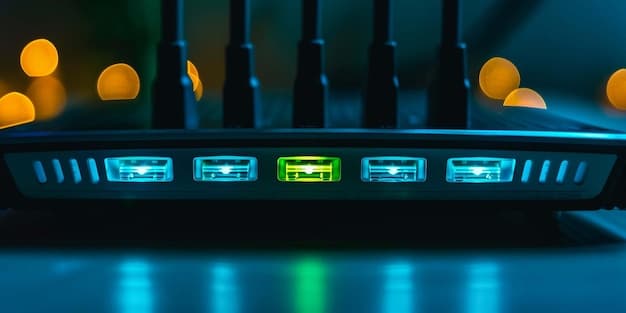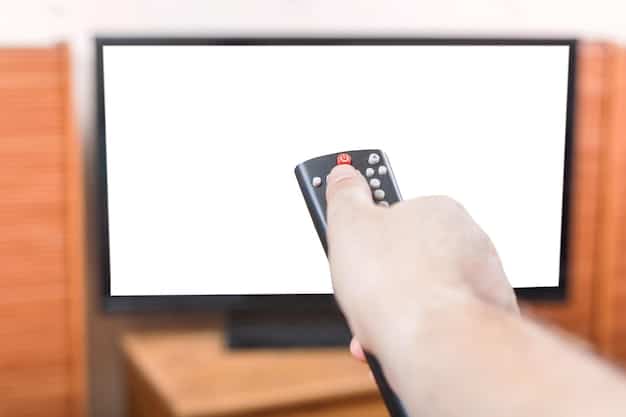Streaming Quality Issues in US (2025): Troubleshooting Guide

Experiencing poor streaming quality in the US by 2025 often stems from common issues like internet speed inconsistencies, Wi-Fi interference, outdated devices, content server congestion, or misconfigured streaming settings, all of which are addressable with systematic troubleshooting.
Ever found yourself lost in a suspenseful plot twist, only for your screen to pixelate into an abstract mess? If you’re asking, Is Your Streaming Quality Suffering? Troubleshoot Common Issues in the US (2025), you’re not alone. Many viewers face frustrating interruptions, blurry images, and constant buffering, turning a relaxing evening into a tech support call waiting to happen. This guide delves into the most prevalent culprits behind your streaming woes, offering practical, actionable solutions to get you back to seamless entertainment.
Understanding the Basics of Streaming Quality
Before diving into fixes, it’s essential to grasp what contributes to good streaming quality. It’s a delicate balance of several components working in harmony. Think of it as a finely tuned orchestra where each instrument must play its part. If one is off-key, the whole performance suffers.
The core elements include your internet service provider (ISP), your home network setup, the device you’re streaming on, and the content delivery network (CDN) of the streaming service itself. Each presents potential bottlenecks that can severely impact your viewing experience. Understanding these foundational layers is the first step toward effective troubleshooting.
Your Internet Connection: The Foundation of Streaming
Your internet speed is paramount. While most services recommend a minimum speed for HD and 4K content, this is often a baseline. Shared bandwidth, especially in households with multiple users and devices, can quickly consume available capacity. Furthermore, the type of connection you have (fiber, cable, DSL, satellite) significantly impacts consistency and maximum speeds.
- Fiber Optic: Generally offers the most stable and highest speeds.
- Cable: Often fast but can experience slowdowns during peak usage times in your neighborhood.
- DSL: Slower, typically more prone to distance-based signal degradation.
- Satellite: Prone to high latency and weather interference, making it less ideal for real-time streaming.
Even if your subscribed speed is high, external factors like ISP throttling or network congestion can reduce your effective bandwidth, transforming crisp visuals into a pixelated mess. It’s crucial to distinguish between advertised speeds and real-world performance, usually measured through speed tests.
A reliable connection is the backbone. Without sufficient and consistent bandwidth, even the most advanced streaming device will struggle to deliver high-quality video. This foundational aspect is often overlooked, with users immediately blaming their devices or the streaming platform when, in reality, their internet service is the primary culprit.
Diagnosing Wi-Fi Weaknesses and Interference
Even with a robust internet connection, a weak or congested Wi-Fi signal can cripple your streaming quality. Wi-Fi operates on radio waves, which are susceptible to interference from other devices, physical obstructions, and even neighboring networks. This interference translates to reduced speed and unstable connections, leading to buffering and quality drops.
Many households overlook the placement of their router. Placing it in a centralized location, away from thick walls, metal objects, and other electronics, can significantly improve signal strength. Additionally, the age and capabilities of your router play a vital role. An older router may not support newer Wi-Fi standards (like Wi-Fi 6 or 6E), limiting the speeds your modern devices can achieve.
Common Sources of Wi-Fi Interference
Interference isn’t always obvious. It can come from a myriad of sources within your home and from outside. Identifying these is key to mitigating their impact and improving your Wi-Fi performance, and consequently, your streaming quality.
- Other Wireless Devices: Cordless phones, microwave ovens, Bluetooth devices, and even smart home gadgets can operate on similar frequencies, causing signal degradation.
- Physical Obstructions: Walls (especially brick or concrete), large furniture, and even plumbing can block or weaken Wi-Fi signals.
- Neighboring Networks: In densely populated areas, multiple Wi-Fi networks can compete for the same channels, leading to congestion.
Adjusting your router’s channel, moving interfering devices, or upgrading to a mesh Wi-Fi system are all viable strategies. The goal is to create a clear, strong pathway for your data to flow from your router to your streaming device, ensuring minimal latency and consistent speeds for the best possible experience.
Furthermore, older Wi-Fi security protocols, like WEP, can also inadvertently slow down your network. Upgrading to WPA2 or WPA3 offers better security and often better performance. Regularly checking for firmware updates for your router is also crucial, as manufacturers often release stability and performance improvements.

Outdated Devices and Software
In the rapidly evolving world of streaming, your devices and their underlying software can quickly become bottlenecks. An older smart TV, streaming stick, or even a computer might lack the processing power, memory, or updated codecs to handle modern high-bitrate streaming content, especially 4K HDR or Dolby Vision. This isn’t just about speed; it’s about capability.
Think of it like trying to run a graphically intensive video game on an old computer. Even with a fast internet connection, the computer itself can’t render the graphics efficiently. Similarly, an outdated streaming device might struggle to decode video streams, leading to buffering, stuttering, or default lower resolution playback even if your internet can support higher quality.
The Importance of Software and Firmware Updates
Software and firmware updates are not just about security; they often include critical performance enhancements, bug fixes, and support for new streaming technologies. Neglecting these updates can leave your devices performing suboptimally or even incompatible with newer content formats.
- Smart TVs: Regularly check your TV’s settings for system updates.
- Streaming Sticks/Boxes: Devices like Roku, Fire TV, Apple TV, and Chromecast often update automatically, but manual checks are good practice.
- Web Browsers: Ensure your browser is up-to-date, as they are crucial for web-based streaming services.
Many streaming platforms continuously evolve their compression algorithms and streaming protocols. Older devices or software may not efficiently process these newer methods, resulting in a less-than-optimal viewing experience. A simple update can often resolve a myriad of performance issues, ensuring your device is speaking the same language as the streaming server.
Beyond updates, consider the device’s basic specifications. Does it support the latest Wi-Fi standards? Does it have enough RAM to handle simultaneous applications? Sometimes, the most efficient solution is upgrading to a newer model that is specifically designed for current and future streaming demands.
Server Congestion and Content Delivery Networks (CDNs)
While your home setup is crucial, sometimes the problem lies on the streaming service’s end. When millions of users simultaneously access a popular show or live event, the service’s servers can become overloaded, leading to congestion. This is akin to rush hour traffic on a highway – even if your car is fast, you’re stuck moving slowly with everyone else.
Streaming services rely on Content Delivery Networks (CDNs) to distribute content from servers closer to you, reducing latency and improving speed. However, even CDNs can experience localized congestion or technical issues. A specific server node might be overwhelmed, or there could be an routing issue between your ISP and the CDN’s servers.
Impact of Peak Usage Times
You’re most likely to encounter server-side issues during peak viewing hours. This typically includes evenings (7 PM – 11 PM local time) and weekends, especially when major new releases or live sporting events are airing. During these times, even robust CDNs can struggle to keep up with demand, leading to temporary quality degradation.
Unfortunately, there’s little you can do on your end to resolve server congestion. Your best course of action is patience, or to try streaming during off-peak hours. If the problem persists for an extended period, it might be worth checking social media or tech news outlets for widespread reports of outages from the streaming service.
Most major streaming providers like Netflix, Max, Disney+, and Hulu invest heavily in their CDN infrastructure to minimize these occurrences. However, even with the best planning, unforeseen spikes in demand or regional network issues can temporarily impact service quality. It’s a testament to the sheer scale of modern streaming that these issues aren’t more common.
If you suspect server-side issues, try accessing content from a different streaming service to see if the problem is isolated. This helps differentiate between a widespread internet problem and a service-specific issue. Sometimes, simply restarting the streaming application or device can force it to connect to a different, less congested CDN node.
Optimizing Streaming Settings and Data Usage
Many streaming platforms allow you to manually adjust playback quality settings. While convenient for saving data (especially on mobile plans), these settings can inadvertently cap your streaming quality at a lower resolution than your connection or device supports. It’s worth ensuring that your settings are configured for the highest possible quality for your device and internet speed.
Conversely, if you’re experiencing buffering even after checking internet speed and Wi-Fi, manually lowering the quality setting can sometimes provide immediate relief, albeit at the cost of visual fidelity. This acts as a temporary workaround while you troubleshoot deeper issues.
Practical Steps for Setting Adjustments
Before assuming a major technical fault, check the application settings. Sometimes, an automatic setting or a previous quality selection might be limiting your experience. This is especially true for shared accounts where another user might have opted for a data-saving mode.
- Check Streaming App Settings: Look for “Playback Quality,” “Data Usage,” or “Video Quality” options within the streaming application’s settings.
- Browser Settings: For web-based streaming, ensure your browser’s hardware acceleration is enabled (if supported) and that no browser extensions are interfering with video playback.
- Device Settings: Some smart TVs or streaming devices have their own internal video optimization settings that can sometimes conflict with streaming app settings.
Be mindful of background data usage. Other applications or devices on your network might be consuming significant bandwidth, even if they aren’t actively streaming. Features like cloud backups, large file downloads, or even automatic updates can quietly hog your internet connection, leaving insufficient bandwidth for your primary streaming activity.
Optimizing isn’t just about turning dials up; it’s about finding the sweet spot for your specific setup. A higher quality setting isn’t always better if your network can’t sustain it consistently. Balancing visual quality with a stable, buffer-free experience is the ultimate goal.
It’s also worth noting that some streaming services offer “adaptive” bitrate streaming, which automatically adjusts video quality based on your current network conditions. While this is generally beneficial, a rapidly fluctuating internet connection can cause constant quality changes, which can be just as disruptive as buffering. In such cases, manually setting a resolution might provide a more consistent experience.

ISP Throttling and Network Congestion in the US (2025)
Internet Service Providers (ISPs) in the US sometimes employ traffic management practices, which can include bandwidth throttling, especially for specific types of traffic like streaming video. While often framed as a way to manage network congestion, it can significantly impact your streaming quality, even if you subscribe to high-speed plans.
Network congestion, distinct from ISP throttling, refers to a genuine overload on a particular segment of the ISP’s infrastructure. This is more common in older or less developed network areas. Both throttling and congestion manifest as slower speeds and buffering, making them difficult to distinguish without proper tools.
Identifying and Addressing ISP-Related Issues
Pinpointing ISP throttling or network congestion requires a bit of detective work. Running speed tests at different times of the day, especially during peak and off-peak hours, can reveal inconsistencies. If your speeds drop dramatically only when you’re streaming, and not for general web browsing, it might be an indicator of throttling.
- VPN Usage: Sometimes, using a Virtual Private Network (VPN) can bypass ISP throttling, as it encrypts your traffic, making it harder for the ISP to identify and selectively slow down streaming data.
- Contacting Your ISP: If you suspect throttling or persistent congestion, contacting your ISP directly is often the next step. They may be able to provide insights into local network conditions or offer solutions.
- Monitor Network Performance: Tools and apps provided by your router or third-party network monitors can help you keep an eye on your real-time bandwidth usage and spot anomalies.
The regulatory landscape around net neutrality in the US can influence how ISPs manage traffic. By 2025, changes in these policies could further impact throttling practices. Staying informed about your ISP’s policies and local network conditions is crucial for maintaining optimal streaming performance.
Remember that even a good ISP can have bad days or localize issues. It’s not always malicious throttling; sometimes it’s genuinely trying to manage the immense data flow across its network. However, armed with data from your own tests, you’ll be in a much stronger position to advocate for better service.
Advanced Troubleshooting and Prevention Tips
Beyond the common fixes, there are several advanced steps you can take to diagnose and prevent streaming quality issues. These often involve a bit more technical know-how but can yield significant improvements, especially for persistent problems. Investing a little time upfront can save a lot of frustration down the line.
Proactive maintenance of your home network is key. Just like a car needs regular oil changes, your network infrastructure benefits from periodic checks and adjustments. Firmware updates for routers, regular speed tests, and even physical cleaning of ventilation on devices can prolong their lifespan and performance.
Implementing a Mesh Wi-Fi System
For larger homes or those with many dead zones, a mesh Wi-Fi system can be a game-changer. Unlike traditional routers, mesh systems use multiple access points to create a seamless, strong Wi-Fi signal throughout your entire home. This eliminates dead spots and ensures consistent, fast speeds for all your streaming devices, regardless of where they are located.
Consider the placement of your streaming devices. Directly connecting them to your router with an Ethernet cable is always the most reliable option, as it eliminates Wi-Fi interference entirely. If running cables isn’t feasible, ensure your streaming device is as close as possible to the router or a mesh node.
Regular Network Maintenance
A little routine maintenance goes a long way. This includes restarting your router and modem regularly (a simple power cycle can often clear out minor glitches), ensuring all your streaming devices have the latest software updates, and even reviewing your Wi-Fi password for security. A compromised Wi-Fi network can also lead to slower speeds if unauthorized users are utilizing your bandwidth.
Ultimately, a holistic approach to network health will yield the best streaming results. By combining good internet service with a robust home network, up-to-date devices, and optimized settings, you can enjoy an uncompromised streaming experience. Don’t settle for pixelation and buffering when a few strategic adjustments can bring back the crisp, clear picture you deserve.
Furthermore, dedicating a specific Wi-Fi band (e.g., 5GHz) for your streaming devices can help isolate them from more congested 2.4GHz traffic, which is often used by older devices and smart home gadgets. Many modern routers allow for this kind of traffic prioritization, often referred to as Quality of Service (QoS).
| Key Area | Quick Fix/Insight |
|---|---|
| 🚀 Internet Speed | Run speed tests; consider upgrading ISP plan or confirming speeds during peak hours. |
| 📡 Wi-Fi Signal | Improve router placement, reduce interference, or switch to mesh Wi-Fi. |
| 📱 Device/Software | Ensure all streaming devices and apps are fully updated for optimal performance. |
| ⚙️ Streaming Settings | Verify app’s video quality settings and disable background data usage where possible. |
Frequently Asked Questions About Streaming Quality
▼
Nightly buffering often indicates network congestion, either on your local Wi-Fi or with your internet service provider (ISP) during peak usage hours. Many US households experience slowdowns when everyone is streaming simultaneously in the evening. Try restarting your router or checking for ISP outages in your area.
▼
Yes, older smart TVs might lack the necessary hardware, processors, or updated video codecs to efficiently decode and display 4K content, even if your internet speed is sufficient. They may also not support newer Wi-Fi standards or have limited RAM, leading to buffering or lower resolution playback. Consider upgrading your TV or using an external streaming device.
▼
You can suspect ISP throttling if your internet speeds are consistently high for browsing and downloads but significantly drop when you start streaming video. Running speed tests on reputable sites like Speedtest.net at various times, and comparing with and without a VPN, can help reveal if your streaming traffic is being targeted.
▼
Using a VPN can both help and hinder streaming quality. While it can bypass ISP throttling, the encryption and routing through a VPN server can introduce latency and reduce speeds. For optimal performance, choose a premium VPN with fast servers located close to you and specifically optimized for streaming, avoiding free or overloaded options.
▼
To improve Wi-Fi for streaming, place your router centrally, away from obstructions, and consider upgrading to a dual-band or mesh Wi-Fi system. Ensure your router’s firmware is updated, and if possible, use the 5GHz band for streaming devices. Reducing interference from other electronics and using a wired Ethernet connection when feasible will also significantly help.
Conclusion
Navigating the complexities of streaming quality in the US by 2025 can be daunting, but with a structured approach, most issues are resolvable. From ensuring a robust internet connection and optimizing your home Wi-Fi to keeping devices updated and understanding potential ISP practices, each step contributes to a smoother, more enjoyable viewing experience. By systematically addressing these common culprits, you can transform your frustrating buffering sessions into seamless entertainment, fully immersing yourself in your favorite shows and movies without interruption. The power to reclaim your streaming satisfaction is largely within your control.





